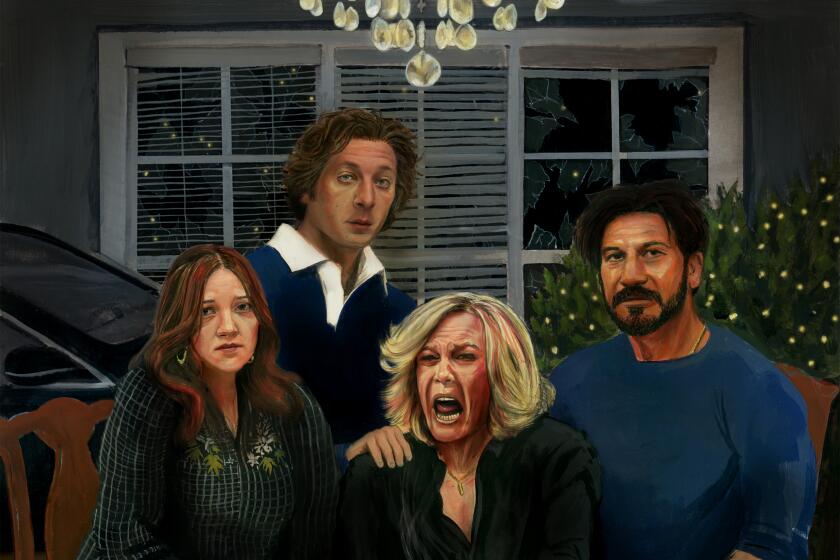‘Blue Is the Warmest Color’ and NC-17 ratings in history

This week, “Blue Is the Warmest Color,” the sexually explicit lesbian love story that won the Palme d’Or at the Cannes Film Festival, becomes the latest high-profile movie to be released with an NC-17 rating from the Motion Picture Assn. of America.
The MPAA established the rating in 1990 to replace the X designation, which had been co-opted by the porn industry.
The NC-17 label means no one under the age of 18 will be admitted to see the movie. It also means that some theater chains won’t show it, some retail chains won’t stock the DVD, and some media outlets won’t carry the ads.
PHOTOS: NC-17 films and why they got the rating
Filmmakers sometimes edit their work to bring the rating down to an R. Some smaller, non-MPAA member distributors decide to let their films go out with no rating at all, which makes it unlikely for them to be shown in many cinemas or make much money. Directors who have chosen this route include Todd Solondz for “Happiness” and Darren Aronofsky for “Requiem for a Dream.”
The people behind “Blue Is the Warmest Color” stuck with the NC-17. Sundance Selects/IFC Films President Jonathan Sehring said earlier this year that the company would not compromise director Abdellatif Kechiche’s vision by “trimming” the picture.
That may pay off, because the MPAA rules are voluntary. According to The Wrap website, one major theater, the IFC Center in New York, has chosen to not enforce the rating, which is not surprising because the theater is owned by the same company that made the movie.
REVIEW: Love at its finest in ‘Blue is the Warmest Color’
It’s safe to say an NC-17 rating is rarely a financial boost at the box office. The top-grossing such film is still the infamous “Showgirls,” the cult classic from 1995 that starred Elizabeth Berkley.
Here’s a look at the top-grossing movies that were released as either NC-17 or unrated, with data compiled by Rentrak. Note: These figures are not adjusted for inflation.
“Showgirls” (1995). Domestic gross: $20.3 million. Directed by Paul Verhoeven, this was the first NC-17 film to get a wide release, and critics tore it to pieces. Here’s a choice paragraph from the Los Angeles Times: “Everything you feared it might be and less, ‘Showgirls’ is a movie made to be exploited, not seen. Both in print and in the TV teaser trailers, this picture manages to appear more involving and provocative than it actually is. No one is expecting ‘Thirty-Two Short Films About Glenn Gould,’ but even in the pulp trash genre certain minimal standards must be observed.”
“Henry & June” (1990). Domestic gross: $11.6 million. “Henry and June,” an art-house effort that dramatized the romance between Henry Miller and Anais Nin, was one of the first films to receive the NC-17 rating.
PHOTOS: Behind the scenes of movies and TV
“The Cook, The Thief, His Wife and Her Lover” (1990). Domestic gross: $7.72 million. Another one of the first to get the NC-17 tag, this was director Peter Greenaway’s most famous film.
“Kids” (1995). Domestic gross: $7.41 million. A film, directed by Larry Clark, about a skateboarder who tries to infect people with HIV. This movie was released by non-MPAA signatory company Excalibur, which Miramax -- an MPAA member -- created in order to have the movie go out unrated.
“Bad Education” (2004). Domestic gross: $5.2 million. Written and directed by Pedro Almodovar, already known for films such as “Matador,” “Law of Desire,” “Talk to Her” and “All About My Mother,” this Spanish film received wide critical praise. It received the rating for explicit sexual content.
“Lust, Caution” (2007). Domestic gross: $4.6 million. This was Ang Lee’s lengthy Chinese-language thriller set in World War II-era Shanghai. Wrote Times critic Kenneth Turan: “A brooding meditation on the unnerving power and terrible cost of emotional and political masquerades.”
PHOTOS: Billion-dollar movie club
“Tie Me Up, Tie Me Down” (1990). Domestic gross: $4.09 million. Another Pedro Almodovar film. In this case, Miramax sued when the MPAA gave it the stigmatized X rating, and then released the movie unrated.
“Shame” (2011). Domestic gross: $4 million. An NC-17 critical darling starring Michael Fassbender as a sex addict.
“Crash” (1996). Domestic gross: $3.09 million. Not the Oscar-winning film by Paul Haggis. This was David Cronenberg’s controversial film that depicted people who are sexually aroused by, among other things, car accidents.
“The Dreamers” (2004). Domestic gross: $2.5 million. Directed by Bernardo Bertolucci and written by Gilbert Adair, who wrote “The Holy Innocents,” upon which the movie is based.
“The Pillow Book” (1997). Domestic gross: $2.37 million. No rating at all for this steamy, Ewan McGregor-starring film.
ALSO:
Michael Fassbender is poised to strike
Johnny Knoxville takes golden-years raunch on the road
Why Spike Jonze and Catherine Keener were cut out of ‘Bad Grandpa’
Twitter: @rfaughnder
More to Read
From the Oscars to the Emmys.
Get the Envelope newsletter for exclusive awards season coverage, behind-the-scenes stories from the Envelope podcast and columnist Glenn Whipp’s must-read analysis.
You may occasionally receive promotional content from the Los Angeles Times.







